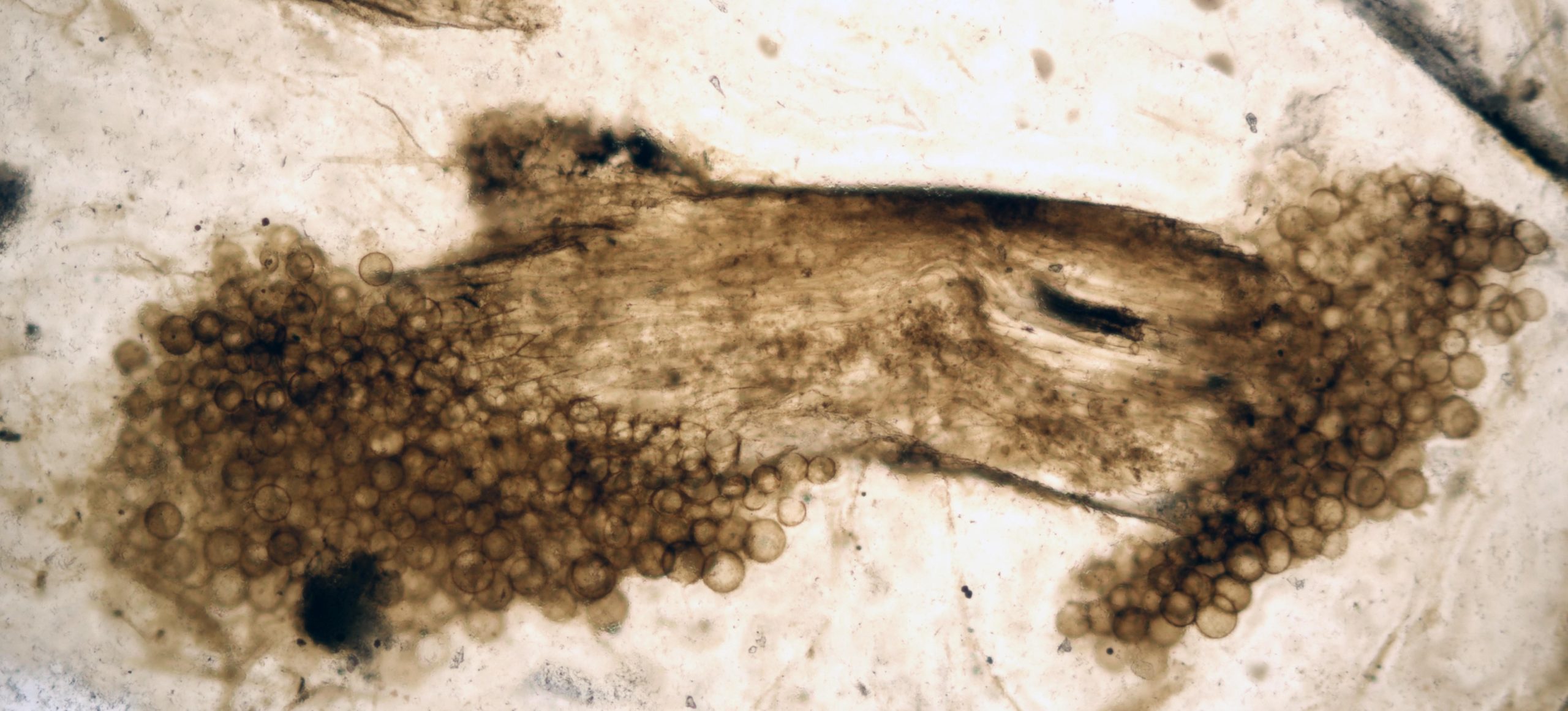400 milyon yıllık önbelleğe alınmış fosiller erken yaşamı ortaya koyuyor

Mikroskopla görülen, uzuvlarda kolonize olan fosil mantarlara sahip küçük bir fosil Ren bitkisi parçası. Kredi bilgileri: Loron ve ark.
En son teknoloji, Dünya’daki erken yaşam hakkında önemli ipuçları sağlayabilecek dünyaca ünlü bir fosil hazinesi hakkında yeni bilgiler ortaya çıkardı.
İskoçya’nın uzak kuzeydoğu bölgesinde ortaya çıkarılan 400 milyon yıllık fosil zulasını araştıran bilim adamları, sonuçlarının bu fosillerde önceden tahmin edilenden daha yüksek düzeyde moleküler koruma gösterdiğini bildirdiler.
Aberdeenshire’dan zarif bir şekilde korunmuş hazine hazinesinin yeni incelemesi, bilim adamlarının içindeki çeşitli organizmaların kimyasal parmak izlerini tanımlamasını sağladı.
Rosetta Stone’un Mısır bilimcilerin hiyeroglifleri tercüme etmesine yardımcı olması gibi, ekip bu simya sembollerinin diğer, daha belirsiz fosiller tarafından temsil edilen yaşam formlarının kimliği hakkında daha fazla anlamaya yardımcı olacağını umuyor.
1912’de Aberdeenshire’daki Rhynie köyü yakınlarında keşfedilen çarpıcı fosil ekosistemi mineralize edilmiş ve silikadan oluşan sert kaya ile kaplanmıştır. Rhynie chert olarak bilinen, yaklaşık 407 milyon yıl önce, erken Devoniyen dönemine aittir ve bilim adamlarının Dünya’daki yaşam anlayışında önemli bir rolü vardır.
Araştırmacılar en son tahribatsız görüntüleme, veri analizi ve[{” attribute=””>machine learning to analyze fossils from collections held by National Museums Scotland and the Universities of Aberdeen and Oxford. Scientists from the University of Edinburgh were able to probe deeper than has previously been possible, which they say could reveal new insights about less well-preserved samples.
Employing a technique known as FTIR spectroscopy – in which infrared light is used to collect high-resolution data – researchers found impressive preservation of molecular information within the cells, tissues, and organisms in the rock.
Since they already knew which organisms most of the fossils represented, the team was able to discover molecular fingerprints that reliably discriminate between fungi, bacteria, and other groups.
These fingerprints were then used to identify some of the more mysterious members of the Rhynie ecosystem, including two specimens of an enigmatic tubular “nematophyte”.
These strange organisms, which are found in Devonian – and later Silurian – sediments have both algal and fungal characteristics and were previously hard to place in either category. The new findings indicate that they were unlikely to have been either lichens or fungi.
Dr. Sean McMahon, Chancellor’s Fellow from the University of Edinburgh’s School of Physics and Astronomy and School of GeoSciences, said: “We have shown how a quick, non-invasive method can be used to discriminate between different lifeforms, and this opens a unique window on the diversity of early life on Earth.”
The team fed their data into a machine learning algorithm that was able to classify the different organisms, providing the potential for sorting other datasets from other fossil-bearing rocks.
The study, published in Nature Communications, was funded by The Royal Society, Wallonia–Brussels International, and the National Council of Science and Technology of Mexico.
Dr Corentin Loron, Royal Society Newton International Fellow from the University of Edinburgh’s School of Physics and Astronomy said the study shows the value of bridging paleontology with physics and chemistry to create new insights into early life.
“Our work highlights the unique scientific importance of some of Scotland’s spectacular natural heritage and provides us with a tool for studying life in trickier, more ambiguous remnants,” Dr. Loron said.
Dr. Nick Fraser, Keeper of Natural Sciences at National Museums Scotland, believes the value of museum collections for understanding our world should never be underestimated.
He said: “The continued development of analytical techniques provides new avenues to explore the past. Our new study provides one more way of peering ever deeper into the fossil record.”
Reference: “Molecular fingerprints resolve affinities of Rhynie chert organic fossils” by C. C. Loron, E. Rodriguez Dzul, P. J. Orr, A. V. Gromov, N. C. Fraser and S. McMahon, 13 March 2023, Nature Communications.
DOI: 10.1038/s41467-023-37047-1

“Web hayranı. Tipik düşünür. İçine kapanık. Amatör iletişimci. Pop kültürü meraklısı.”
